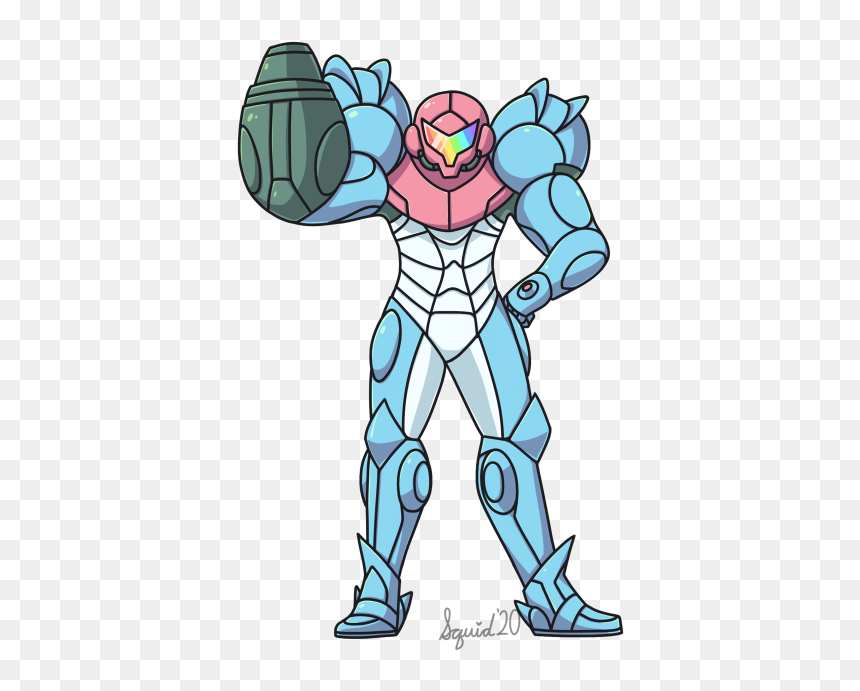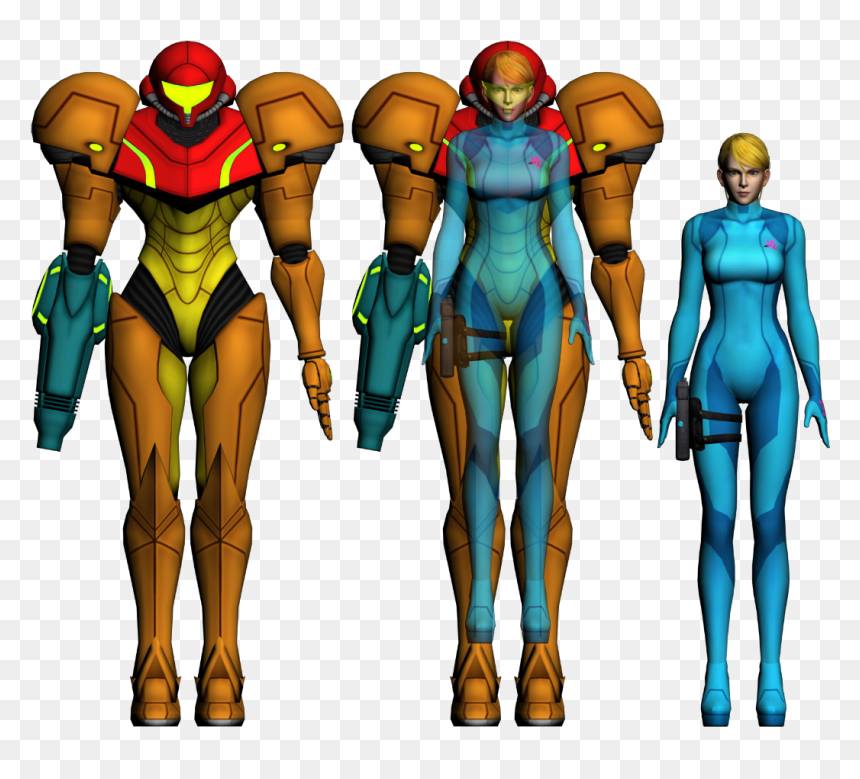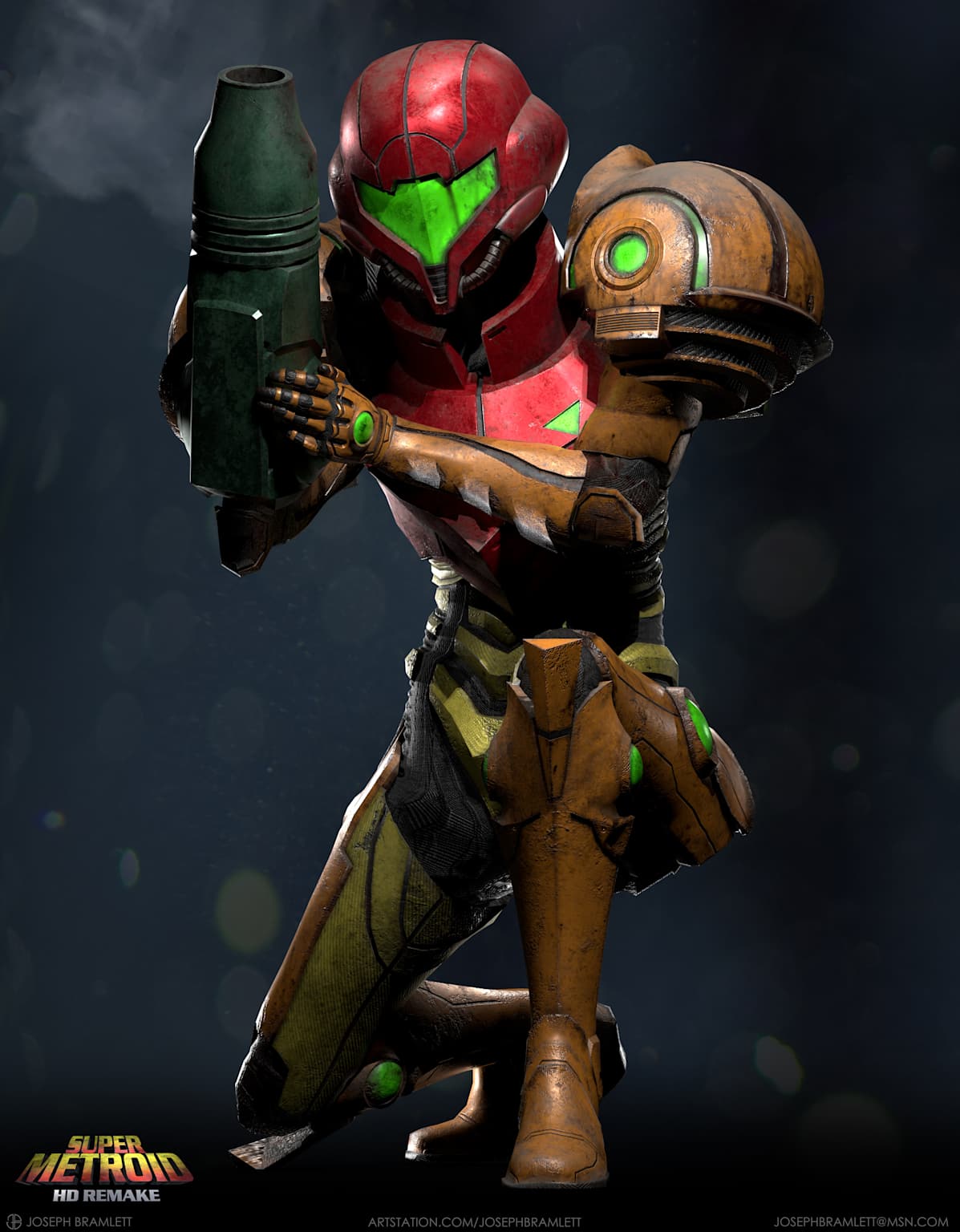Metroid stands as one of Nintendo’s most influential and enduring franchises, having captivated gamers for nearly four decades with its unique blend of exploration, atmospheric storytelling, and groundbreaking character design. Since its debut in 1986, the series has sold over 17.44 million copies worldwide and fundamentally shaped the action-adventure genre through its innovative “Metroidvania” gameplay style. The franchise chronicles the adventures of bounty hunter Samus Aran as she battles the Space Pirates and their attempts to harness the power of the parasitic Metroid organisms across various alien worlds. With recent commercial successes like Metroid Dread becoming the best-selling entry in the series at 2.9 million copies, and the highly anticipated Metroid Prime 4: Beyond scheduled for 2025, the franchise continues to evolve while maintaining its core identity of atmospheric exploration and non-linear progression.

Cartoon drawing of Samus Aran in her iconic Power Suit from the Metroid series vhv
The Origins and Evolution of the Metroid Franchise
Metroid debuted in Japan on August 6, 1986, for the Famicom Disk System, later releasing in North America in August 1987 and PAL regions in January 1988. The game was created by a team of five key figures at Nintendo: Satoru Okada directed the project, Yoshio Sakamoto served as character designer, Gunpei Yokoi produced the game, Makoto Kano wrote the storyline and setting, and Hiroji Kiyotake created critical character designs. This collaborative effort resulted in a revolutionary gaming experience that departed significantly from the linear platformers dominating the market at the time.
The original Metroid introduced several groundbreaking concepts that would become genre-defining elements. Unlike virtually every other side-scrolling game of its era, Metroid didn’t limit players to linear progression from left to right. Instead, players could explore freely in all directions – left, right, up, and down – through an interconnected world where progression depended entirely on acquiring new abilities and equipment. The game’s approach was fundamentally different from contemporary titles, using items as navigational tools as much as weapons, creating the memorable experience of discovering inaccessible areas that could only be reached after obtaining specific upgrades.
The franchise consists of eleven main video games spanning multiple Nintendo console generations, with each entry building upon the core exploration mechanics while introducing new elements. The series experienced significant evolution from its 2D origins to encompass both traditional side-scrolling adventures and first-person 3D experiences through the Metroid Prime sub-series. This diversification allowed the franchise to maintain relevance across different gaming eras while preserving its essential identity of atmospheric exploration and ability-based progression.
Samus Aran: Gaming’s Revolutionary Female Protagonist

Samus Aran in her Power Suit and Zero Suit from the Metroid series, showing both armored and unarmored forms
Samus Aran represents one of gaming’s most significant character revelations and stands as a pioneering figure in video game representation. Created by Makoto Kano and designed by Hiroji Kiyotake, Samus was introduced in the original 1986 Metroid with a carefully orchestrated gender reveal that shocked players worldwide. The character’s gender was deliberately concealed throughout the game, with the instruction manual using male pronouns to maintain the deception until players completing the game in under five hours were rewarded with the revelation that the armored bounty hunter was actually a woman.
The decision to make Samus female arose during development when the team sought ways to surprise players and create memorable endings based on completion time. According to series veteran Yoshio Sakamoto, “Then someone said, ‘It would be a shocker if Samus turned out to be a woman!’ And everyone thought that would be interesting and wanted to do it, so we decided it right away”. This revelation was groundbreaking for 1986, introducing one of gaming’s first capable female action heroes at a time when such protagonists were virtually nonexistent in the medium.
Samus’s background story adds depth to her character beyond the initial gender reveal. She was orphaned as a child when Space Pirates, led by the dragon-like Ridley, attacked and destroyed her home colony of K-2L. After this tragedy, she was raised by the bird-like Chozo aliens, who not only trained her but infused her with their DNA, granting her enhanced physical capabilities. This unique origin story provided the foundation for her career as a galactic bounty hunter and her ongoing conflict with the Space Pirates and their various allies.
The character’s design deliberately emphasized capability over conventional femininity, particularly in her iconic Power Suit. Samus’s appearance outside the suit was influenced by actress Sigourney Weaver’s portrayal of Ellen Ripley in Aliens, as well as Kim Basinger’s roles in various films. This design philosophy created a character whose strength and competence took precedence over traditional gender stereotypes, making her an important symbol for representation in gaming that continues to resonate with players today.
Major Games and Franchise Milestones
The Classic 2D Era
The foundation of the Metroid series rests on its classic 2D entries, each contributing unique elements to the franchise’s evolution. Following the original Metroid, the series continued with Metroid II: Return of Samus in 1991 for the Game Boy, which introduced a more linear progression structure while maintaining the core exploration elements. This sequel tasked Samus with exterminating all remaining Metroids on planet SR388, introducing the gameplay mechanic of area-based progression where new regions only became accessible after eliminating all Metroids in the current area.
Super Metroid, released in 1994 for the Super Nintendo Entertainment System, is widely regarded as the pinnacle of 2D Metroid design and one of the greatest video games ever created. The game refined and perfected the exploration-based gameplay of its predecessors, introducing elements like the map system, improved controls, and more sophisticated environmental storytelling. Super Metroid’s influence extends far beyond the Metroid series itself, serving as a template for countless games in what would later be termed the “Metroidvania” genre.
The Game Boy Advance era brought two significant entries: Metroid Fusion in 2002 and Metroid: Zero Mission in 2004. Metroid Fusion introduced a more narrative-driven approach while maintaining core gameplay mechanics, while Zero Mission served as a comprehensive remake of the original Metroid with enhanced graphics, additional content, and modern gameplay refinements. These titles demonstrated the franchise’s ability to evolve while preserving its essential character, setting the stage for future innovations.
The Prime Revolution
The Metroid Prime series, beginning with the original Metroid Prime in 2002, successfully translated the franchise’s 2D exploration mechanics into a first-person 3D environment. Developed by Retro Studios for the GameCube, the game achieved the seemingly impossible task of maintaining the series’ core identity while completely reimagining its presentation and gameplay mechanics. Metroid Prime sold over 2.84 million copies, making it one of the best-selling entries in the franchise until recently.
The Prime trilogy expanded with Metroid Prime 2: Echoes in 2004 and Metroid Prime 3: Corruption in 2007, each adding new mechanics and storylines while maintaining the first-person exploration formula. These games introduced multiplayer components, motion controls, and expanded lore that deepened the Metroid universe. The success of the Prime series demonstrated the franchise’s versatility and ability to successfully transition between different gaming paradigms.
Metroid Prime Remastered, released in 2023 for the Nintendo Switch, brought the original Prime experience to modern audiences with enhanced visuals and multiple control options. This remaster has been part of the combined 4.99 million units sold for Metroid games on Nintendo Switch, contributing to what Nintendo considers the franchise’s dramatic sales growth on the platform.
Commercial Performance and Market Impact
Sales Evolution and Success Metrics

Major Metroid game sales comparison
The Metroid franchise has experienced a complex relationship with commercial success throughout its history, often being perceived as a critical darling that struggled commercially compared to Nintendo’s other major franchises. However, recent entries have challenged this narrative significantly. As of September 2012, the entire Metroid series had sold over 17.44 million copies across all platforms, a respectable figure that nonetheless paled in comparison to franchises like Mario or Zelda.
The series achieved a major commercial milestone with Metroid Dread, which launched for Nintendo Switch in October 2021 and became the best-selling Metroid game of all time with 2.9 million copies sold. This achievement is particularly significant as Dread surpassed the previous record holder, the original Metroid Prime, by approximately 60,000 copies, marking the first time a 2D Metroid entry had achieved such commercial success. The game’s success was supported by a strong marketing campaign including prominent television advertisements, demonstrating Nintendo’s commitment to promoting the franchise.
Metroid Dread’s commercial performance provides interesting insights into the series’ global appeal. Of the 2.9 million total sales, only 270,000 copies were sold in Japan compared to 2.63 million elsewhere, indicating that the franchise has significantly stronger appeal in Western markets. This distribution pattern has been consistent throughout the series’ history, with Western audiences showing greater appreciation for the franchise’s atmospheric exploration and science fiction themes.
Comparative Market Position
Despite Dread’s success, the sales figures highlight the franchise’s position within Nintendo’s portfolio. While 2.9 million copies represents a significant achievement for Metroid, it remains modest compared to other recent Nintendo releases. For comparison, Kirby: The Forgotten Land sold 2.1 million copies in just its first week, while Mario Party Superstars achieved 6.88 million sales and The Legend of Zelda: Skyward Sword HD reached 3.91 million copies. This context demonstrates that while Metroid has found commercial success, it continues to serve a more niche audience compared to Nintendo’s broader franchises.
The franchise’s commercial trajectory on Nintendo Switch has been particularly notable, with Nintendo officially recognizing Metroid as experiencing “dramatic sales growth” on the platform compared to previous console generations. The combined sales of Metroid Dread and Metroid Prime Remastered totaling 4.99 million units represent a significant improvement over the franchise’s performance on Nintendo 3DS and Wii U, where titles like Metroid Prime: Federation Force and Metroid: Samus Returns achieved only 0.98 million sales combined.
Cultural Impact and the Birth of Metroidvania
Defining a Genre

High-resolution fan art of Samus Aran in her iconic Power Suit from Super Metroid HD Remake josephbramlett.artstation
The Metroid franchise’s most significant contribution to gaming extends beyond its individual commercial success to its fundamental influence on game design philosophy. The term “Metroidvania” has become a recognized genre designation, combining elements from both Metroid and Castlevania series to describe games featuring interconnected world design, ability-based progression, and non-linear exploration. The earliest recorded use of this terminology dates back to 2001, specifically referencing Castlevania: Circle of the Moon as a game inspired by Metroid’s design principles.
The genre’s defining characteristics were established primarily through the original Metroid and refined through Super Metroid, which many consider the definitive template for Metroidvania design. These games introduced the concept of using acquired abilities as both combat tools and navigational keys, creating interconnected worlds where players must revisit areas with new capabilities to access previously unreachable locations. This design philosophy has influenced countless independent developers and major studios, leading to successful modern interpretations like Ori and the Blind Forest, Shadow Complex, and hundreds of independent titles.
The cultural significance of the Metroidvania genre extends beyond gaming into broader discussions of interactive media design. The non-linear progression system pioneered by Metroid has been analyzed as a form of environmental storytelling, where the world itself communicates narrative elements through its structure and accessibility. This approach has influenced game design education and development philosophy, establishing principles that continue to guide contemporary game creation.
Influence on Game Development
Metroid’s impact on the gaming industry encompasses both direct spiritual successors and subtle influences on mainstream game design. The franchise’s emphasis on atmospheric exploration and environmental storytelling has become a standard approach for many action-adventure games. The concept of “gated progression” – where player advancement is tied to acquiring specific abilities rather than simply completing linear challenges – has been incorporated into numerous modern gaming experiences across multiple genres.
The series’ approach to world design has particularly influenced independent game developers, who have embraced the Metroidvania format as an effective structure for smaller development teams. The genre’s emphasis on interconnected level design and ability-based progression provides a framework that allows for compelling gameplay experiences without requiring the massive content volume associated with open-world games. This accessibility has led to a renaissance of Metroidvania-style games in the independent gaming scene, ensuring the franchise’s design principles continue to evolve and reach new audiences.
The Future of Metroid
Metroid Prime 4: Beyond

Metroid Prime Remastered box art featuring Samus Aran in her power suit screenrant
The most significant upcoming entry in the Metroid franchise is Metroid Prime 4: Beyond, scheduled for release in 2025 on Nintendo Switch27. Originally announced at E3 2017 as simply “Metroid Prime 4,” the game experienced significant development challenges that led to a complete restart of the project in 2019. Nintendo announced that development had been transferred from Bandai Namco Studios to Retro Studios, the original developers of the Prime series, due to the previous development progress not meeting Nintendo’s standards for a Prime sequel.
The game’s development restart proved beneficial, as the June 2024 trailer showcasing Metroid Prime 4: Beyond demonstrated impressive visual quality and smooth gameplay that pushes the technical limits of the Nintendo Switch27. The trailer revealed that Samus will explore the jungle planet Viewros while confronting the antagonist Sylux, a bounty hunter who has appeared in previous Prime games and has been positioned as a recurring threat throughout the series. The inclusion of Sylux as the primary antagonist represents a continuation of storylines established in earlier Prime titles, suggesting a cohesive narrative conclusion to the Prime series arc.
Metroid Prime 4: Beyond is expected to be one of the final major exclusive titles for the original Nintendo Switch before the launch of its successor console. The game may potentially launch across both platforms, though Nintendo has not confirmed cross-generation availability. The title’s 2025 release window positions it as a significant conclusion to the Switch’s library and a potential bridge to Nintendo’s next gaming generation.
Franchise Outlook and Continued Evolution
The commercial success of Metroid Dread and Metroid Prime Remastered has positioned the franchise in its strongest commercial position in decades, with Nintendo now internally considering Metroid a “top-selling” franchise. This recognition suggests increased support and resources for future Metroid projects, potentially including both 2D entries continuing Dread’s storyline and additional 3D Prime experiences. The positive reception of Mercury Steam’s work on Dread indicates that Nintendo has found successful external development partners capable of maintaining the franchise’s quality standards while introducing fresh perspectives.
The franchise’s future success will likely depend on maintaining the delicate balance between innovation and tradition that has defined its most successful entries. The evolution from 2D to 3D, the successful integration of modern gaming elements while preserving core exploration mechanics, and the ability to attract both longtime fans and new audiences demonstrate the franchise’s adaptability. With the strong foundation established by recent releases and the anticipated conclusion of the Prime series, Metroid appears positioned for continued growth and influence in the gaming landscape.
The enduring appeal of Metroidvania gameplay mechanics suggests that demand for Metroid-style experiences will continue, whether through official Nintendo releases or the thriving independent development scene inspired by the franchise. As gaming technology continues advancing, the core principles established by the original Metroid – atmospheric exploration, environmental storytelling, and ability-based progression – remain as relevant and compelling as they were nearly four decades ago.
Conclusion
Metroid has evolved from a groundbreaking 1986 experiment into one of gaming’s most influential and enduring franchises. Through its innovative protagonist Samus Aran, revolutionary gameplay design, and genre-defining influence, the series has maintained cultural relevance across multiple console generations while inspiring countless developers and defining an entire subgenre of gaming. The recent commercial success of Metroid Dread and the upcoming release of Metroid Prime 4: Beyond demonstrate that the franchise continues to find new audiences while satisfying longtime fans.
The series’ journey from commercial uncertainty to Nintendo’s recognition as a “top-selling” franchise represents a remarkable transformation driven by quality game design, strategic marketing, and the enduring appeal of atmospheric exploration gameplay. As the gaming industry continues evolving, Metroid’s core principles of environmental storytelling, non-linear progression, and immersive world design remain as relevant and influential as ever, ensuring the franchise’s continued importance in gaming culture and development practices.
